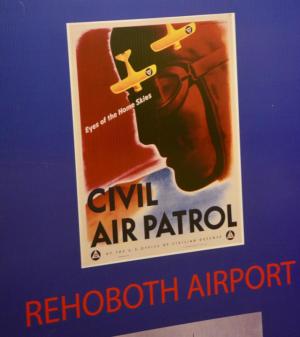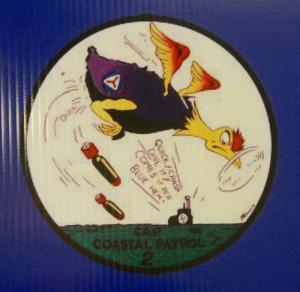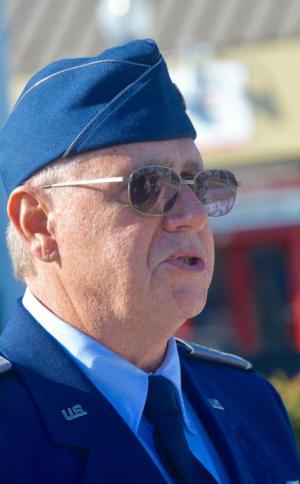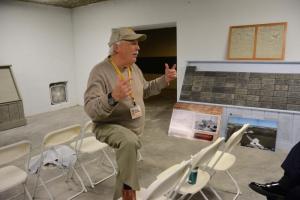Air war waged from Rehoboth Beach airport
The Rehoboth Beach airport is only a memory today. But during the early days of World War II, it was pivotal to securing the Atlantic Coast from unrelenting attacks on U.S. ships by German submarines.
Had it not been for the heroic efforts of the Civil Air Patrol – formed on Dec. 1, 1941 – hundreds more ships and thousands more lives would have been lost.
Coastal Patrol Base 2 in Rehoboth Beach was among the first of 21 bases activated, from Bar Harbor, Maine, to Brownsville, Texas.
Eighteen months of vigilant bombing and surveillance missions eventually paid off, and German submarines scaled back their attacks. These were civilians, flying retrofitted planes with bombing racks, who conducted routine patrols as far out as 60 miles off the coast.
Flying out of where Airport Road is today, local pilots were in the thick of it, flying missions looking for German U-boats from Feb. 26, 1942, to Sept. 28, 1943. Base 2 flew the very first mission, made the first sub sighting and was home to the first two civilians ever awarded the Air Medal, said Everett Bennett, who has done extensive research on the local base.
The only reminder of the Rehoboth airfield – which closed in 1987 – is a state historical marker placed along Airport Road in 2006; the field is now the Rehoboth Shores Estates community.
In early spring 1942, German subs sank a reported 25 ships along the East Coast, and that number increased to 52 in May alone. But as Civil Air Patrol pilots took to the skies, sinkings fell to 35 in June. By the time all 21 bases were in operation, there were almost no sinkings; only three were reported in 1943.
Very few German subs were actually hit by bombs, yet the deterrent factor can't be underplayed, said author Roger Thiel. Flying just a few hundred feet above the water, the pilots could easily spot surfaced subs and radio their positions, distracting subs from their missions and forcing them to go farther out to sea. “Their efforts influenced U-boat tactics and secured safety for U.S. merchant shipping,” Thiel said.
Celebrating 75th anniversary of Base 2
Current Civil Air Patrol officers, cadets and volunteers gathered Feb. 24 to honor the 75th anniversary of the activation of Base 2.
The group toured Fort Miles, talked with the public at the Rehoboth Museum and finished the day by laying a wreath at a memorial near the Rehoboth Beach Bandstand.
Thanks to an impressive six-panel display compiled by Fort Miles Historical Association volunteers Bennett and Mike Dunkes, the base's history has come back to life, complete with historical photos.
The display is located in the Fort Miles Museum in Cape Henlopen State Park.
There was a definite connection between Fort Miles and the CAP, Bennett said. While the fort's 34 guns protected Delaware Bay from a sea attack, the volunteer flyers were searching for subs. “It was all in support of Fort Miles,” he said.
There were as many as 70 members assigned to Base 2, including women, and wives of flyers.
When the base was deactivated in fall 1943, pilots carried supplies and towed targets for Fort Miles gunnery crews. Pilots were also instrumental in providing air cover for convoys.
The last surviving member of Base 2 passed away in 2013, but today's members have not let their legacy fade. Thiel, author of “America's Homefront Air War in World War II,” has made it his life's mission to tell the untold story of the CAP's successful retaliation against the invasion of America's East Coast.
“We absolutely needed them,” Thiel said.
Thiel said the unusual home-guard force had one foot in and one foot out of the military. They flew civilian aircraft carrying bombs, flying way beyond safe limits, often with makeshift equipment, he said.
Many members were either too young or too old for regular military service, but that did not mean those who were eligible could not be called to active duty. Thiel said they signed contracts for three to six months or “for the duration” and were paid per diem. Uniforms were worn and ranks established, yet base members could walk away from duty at any time.
“Everything was adapted, leveraged, unique, hybridized, creative, unusual, custom, special, begged, borrowed or appropriated, but their effort endures as a hallmark of efficiency,” Thiel wrote.
Base 2 members stayed in touch
Thiel said Base 2 airmen were unique because they were the only ones who had annual reunions starting in 1948. Into the late 1970s, 12 to 15 members were still attending, Thiel said, and six members were present at the 60th anniversary celebration in 2002.
The 1992 reunion was perhaps the most unusual in post-war Civil Air Patrol history. Fred Geils, a radar operator on German U-737, was invited to attend. On the night of June 10-11, 1942, the sub laid 15 mines six miles off the shore of Rehoboth Beach.
An American tugboat hit one of the mines and was destroyed as CAP pilot Lt. Roland “Tom” O'Day watched from his plane. It was O'Day who first put out his hand to greet Geils at the reunion. “He was just doing his job,” O'Day said.
Civil Air Patrol is still active in Sussex County. Coastal Patrol Base 2 Memorial Composite Squadron meets at 7 p.m. on Tuesdays at the National Guard Armory, 109 W. Pine St., Georgetown. Go to dewg.cap.gov/squadronsnew for more information.
Rescue mission ends at White House
Of the many heroic episodes in the history of Base 2, one ended up in the Oval Office.
On July 21, 1942, two planes were on a mission when one plane's engine failure forced it to ditch into the ocean. Its sister plane radioed an emergency call back to base.
Base Commander Maj. Hugh Sharp Jr. and 1st Lt. Eddie Edwards – who flew the very first CAP mission – took off in a Sikorsky amphibian plane, which was not designed for rough ocean waters. They landed the plane at sea but damaged the left wing-float. Edwards picked up the injured pilot, but could not find the other crew member, 1st Lt. Charles Shelfus, one of four Base 2 pilots who lost their lives.
Unable to take off as the wing filled with water, Sharp taxied through the choppy ocean and Edwards crawled out on the undamaged right float to balance the plane as they awaited rescue.
A Coast Guard boat met them at nightfall and towed them to Chincoteague, Va. In February 1943, President Franklin D. Roosevelt awarded Sharp and Edwards the Air Medal. The restored aircraft is on display at the New England Air Museum in Windsor Locks, Conn.
Edwards and 1st Lt. Howard Carter are credited on March 10, 1942, with the first sighting of a German U-boat off the Atlantic coast. Edwards radioed in the position to the U.S. Naval fleet, forcing the sub to dive and leave area waters.
Four Coastal Base 2 members lost at sea
Of 26 CAP airmen on the East Coast who lost their lives, four were from Base 2; all of them died when they were forced to ditch into the ocean after engine failure: 1st Lt. Delmont Garrett and Lt. Paul Towne, March 19, 1943; 1st Lt. H.O. Swift, March 6, 1943; and 1st Lt. Charles Shelfus, July 21, 1942. Their names are inscribed on a memorial at the Rehoboth Beach Bandstand.
86,865 missions flown
244,600 flying hours logged
91 distress calls answered from ships
363 survivors rescued
24 million miles flown
90 aircraft lost
































































